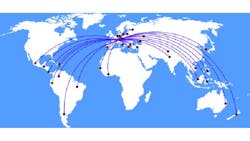New Growth Market for Logistics in 2015 – Non- BRICS
While large BRICS nations (Brazil, Russia, India, China and South Africa) have accounted for much of the logistic sector’s investment in emerging markets, Saudi Arabia climbed to No. 2. in the 2015 Agility Emerging Markets Logistics Index. It ranks behind China, which has 47 times the population and 12.5 times the economic output.
The Index ranks emerging markets based on their size, business conditions, infrastructure and other factors that make them attractive for investment by logistics companies, air cargo carriers, shipping lines, freight forwarders and distribution companies.
Next-tier economies Indonesia (No. 4 in the Index), Nigeria (27), Bangladesh (28) and Pakistan (25) – all with populations topping 100 million – climbed in the Index rankings. The other large non-BRICS market – Mexico -- held steady at No. 9.
“A year ago, there was talk of an emerging markets meltdown and of a new ‘fragile five’ based on concerns about weakness in South Africa, Brazil, India, Turkey and Indonesia,” said Essa Al-Saleh, CEO of Agility Global Integrated Logistics. “Emerging markets as a group turned out to be far more resilient – even vibrant – than expected despite continued sluggishness in the global economy.”
Al-Saleh said a number of developing countries have invested in infrastructure and taken steps to address long-standing problems such as labor and tax rules, investor protections, contract law, property rights, capital restrictions, trade and land-use regulations.
He said risks to emerging markets growth in 2015 will come from falling commodity prices, the cooling Chinese economy, U.S. monetary tightening and Russia’s economic woes.
For 2015, the International Monetary Fund forecasts average growth for the 45 countries featured in the Index at 4.57%.
“The factors driving growth are increases in population, size of the middle class, spending power and urbanization rates, along with steady progress in health, education and poverty reduction,” Al-Saleh said. “That’s why we remain optimistic about emerging markets and continue to see them on an upward trajectory.”
Other Index findings:
- Gulf states UAE, Qatar and Oman, ranked as having the best “market compatibility” – the most ideal business conditions – among the 45 countries in the Index. They were followed by Uruguay, Saudi Arabia and Morocco.
- UAE, Malaysia, China, Oman, Saudi Arabia and Chile led in “connectivity,” indicating they have the best infrastructure and transport links.
- The Philippines climbed three spots (to No. 16) in the data portion of the Index – after jumping nine spots in the 2014 Index. The country also improved its standing among supply chain executives surveyed. They pushed the Philippines up five spots (to No. 15) among countries they said will emerge as a major logistics market.
- Russia’s growing economic isolation has damaged its appeal to logistics and supply chain professionals. More than 75% of survey respondents said they were pessimistic about Russia’s prospects.
- India continues to divide logistics and supply chain executives. They ranked India as the No. 2 choice to emerge as a major logistics market and ranked it relatively high -- No. 17 -- among countries least likely to become a major logistics market. In the data portion of the Index, India was leapfrogged in 2014 by Brazil and Saudi Arabia, and it slipped again in the 2015 Index, falling past Indonesia to No. 5. India’s “market compatibility” – a gauge of business conditions – deteriorated, despite optimism about reform under new Prime Minister Narendra Modi.
- The fastest-growing trade lanes linking emerging and developed markets were US-Vietnam (up 42.7% by volume) and Cambodia-EU (up 41.9%) for air cargo; and Ukraine-EU (up 35.8%) and EU-Egypt (up 23.2%) for ocean shipments. But for 2015, trade flows between Asia’s emerging markets and other emerging markets are the ones that had logistics professionals most upbeat in the survey. Survey respondents also identified risks to growth by region and provided views on near-sourcing, e-commerce and other trends affecting emerging markets.
